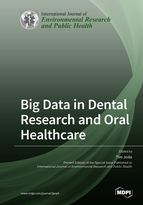Big Data in Dental Research and Oral Healthcare
A special issue of International Journal of Environmental Research and Public Health (ISSN 1660-4601). This special issue belongs to the section "Digital Health".
Deadline for manuscript submissions: closed (15 November 2020) | Viewed by 46054
Special Issue Editor
Interests: reconstructive dentistry; prosthodontics; implant dentistry; digital technology; dental materials; augmented/virtual reality; artificial intelligence; big data & eHealth; public health; translational research
Special Issues, Collections and Topics in MDPI journals
Special Issue Information
Dear Colleagues,
Advances in information technology have fostered a global explosion of data generation. Accumulated big data is now estimated to be 4.4 zettabytes in the digital universe; and trends predict an exponential increase in the future. Health data is gathered from professional routine care and other expanded sources including the social determinants of health, such as internet of things.
Biomedical research has recently moved through three stages in digital healthcare: (1) data collection; (2) data sharing; and (3) data analytics. With the explosion of stored health data, dental medicine is edging into its fourth stage of digitization using new technologies including augmented & virtual reality, artificial intelligence, and blockchain.
Big data collaborations involve interactions between a diverse range of stakeholders with analytical, technical and political focus. In oral healthcare, data technology has many areas of application: prognostic analysis and predictive modeling, identification of unknown correlations of diseases, clinical decision support for novel treatment concepts, public health surveys and population-based clinical research, as well as the evaluation of healthcare systems.
The objective of this Special Issue is to provide an update on the current knowledge with state-of-the-art theory and practical information on human and social perspectives that determine the uptake of technological innovations in big data science in the field of dental medicine. Moreover, it will focus on the identification of future research needs to manage the continuous increase of health data and to accomplish its clinical translation for patient-centered research and personalized dentistry.
This Special Issue welcomes all types of studies and reviews considering the perspectives of different stakeholders on technological innovations for big data science in all dental disciplines.
Prof. Dr. Tim Joda, DMD, MSc, PhD
Guest Editor
Manuscript Submission Information
Manuscripts should be submitted online at www.mdpi.com by registering and logging in to this website. Once you are registered, click here to go to the submission form. Manuscripts can be submitted until the deadline. All submissions that pass pre-check are peer-reviewed. Accepted papers will be published continuously in the journal (as soon as accepted) and will be listed together on the special issue website. Research articles, review articles as well as short communications are invited. For planned papers, a title and short abstract (about 100 words) can be sent to the Editorial Office for announcement on this website.
Submitted manuscripts should not have been published previously, nor be under consideration for publication elsewhere (except conference proceedings papers). All manuscripts are thoroughly refereed through a single-blind peer-review process. A guide for authors and other relevant information for submission of manuscripts is available on the Instructions for Authors page. International Journal of Environmental Research and Public Health is an international peer-reviewed open access monthly journal published by MDPI.
Please visit the Instructions for Authors page before submitting a manuscript. The Article Processing Charge (APC) for publication in this open access journal is 2500 CHF (Swiss Francs). Submitted papers should be well formatted and use good English. Authors may use MDPI's English editing service prior to publication or during author revisions.
Keywords
- Dentistry
- Oral Healthcare
- Dental Research
- Big Data
- Public Health
- Personalized Medicine
- Augmented / Virtual Reality [AR/VR]
- Artificial Intelligence [AI]
- Blockchain






